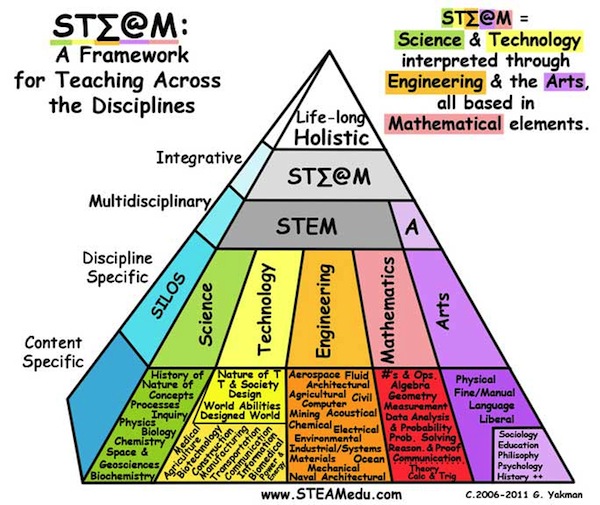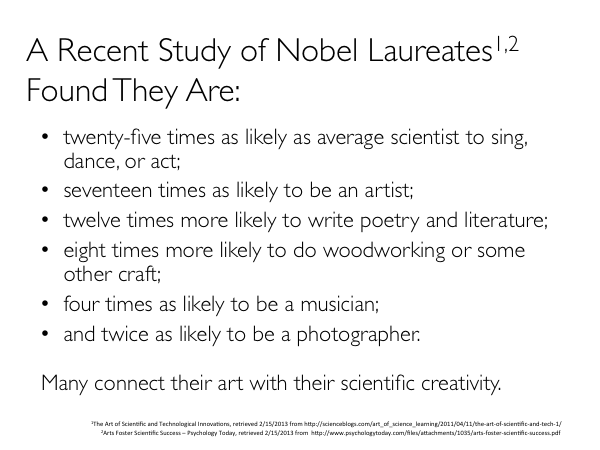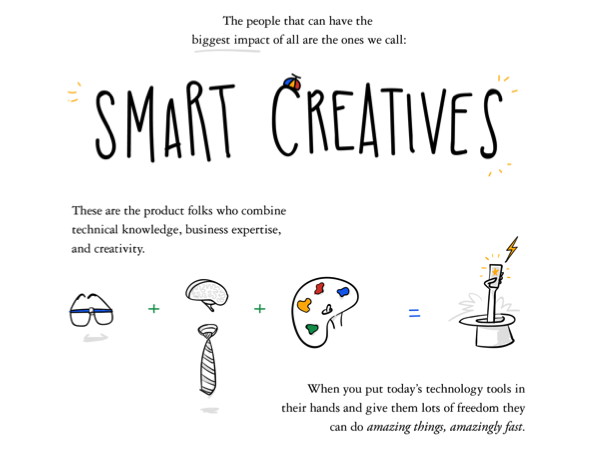
Almost everyone you meet in technology is an advocate of more STEM education — science, technology, engineering, and math. We appreciate that (a) technology careers are relatively stable and pay well; (b) the demand for technologists exceeds their supply, which is a real challenge when you’re looking to hire more technology talent; and (c) our future as a nation and a global community will depend on the breadth and depth of these capabilities in our society — and the innovations that will be birthed from them.
But as marketing technologists, we recognize there’s more to our work than just technical skills. We’re at our best when we harness technology to connect with customers through holistic experiences that incorporate design, imagery, and storytelling. We craft experiences that express ideas and evoke emotions. The phrase the art & science of marketing may be a bit hackneyed, but in a very real sense, that intersection is where we thrive.
However, this blend has often earned marketing technologists the label of “unicorns.”
After all, science, technology, engineering and math are on one end of the spectrum — while art, design, intuition, and creativity are on the opposite end. Right? Surely there are few who are capable of bridging these two disparate worlds, right?
The Two Cultures
Increasingly, of course, we know that’s bunk.
Code requires creativity. Science thrives from the intuitive spark of imaginative hypotheses. And art can leverage technological breakthroughs and mathematical reasoning to produce original works of tremendous beauty and impact. These can be synergistic worldviews, not opposing ones. Many of our hang-ups, as a society, are artificial — largely, I believe, due to the division of these subjects in education.

C. P. Snow, a British scientist and novelist, was one of the first people to vocally denounce this division between the sciences and the humanities in 1959 with a talk and essay he authored, The Two Cultures.
One of the popular excepts from that essay recounts his “stirring of the pot” among intellectuals in the liberal arts:
A good many times I have been present at gatherings of people who, by the standards of the traditional culture, are thought highly educated and who have with considerable gusto been expressing their incredulity at the illiteracy of scientists. Once or twice I have been provoked and have asked the company how many of them could describe the Second Law of Thermodynamics. The response was cold: it was also negative. Yet I was asking something which is the scientific equivalent of: Have you read a work of Shakespeare’s?
A STEAM-Powered Movement
One way of overcoming this divide is to start early and incorporate a more holistic approach in our schools. Georgette Yakman is an educator who has championed integrating arts into STEM curriculum in a framework she invented called STEAM: Science & Technology interpreted through Engineering & the Arts, all based in Mathematical elements.
It’s her diagram, which I love, at the top of this post.
For several great examples of this integrative approach to teaching, here’s a terrific article in THE Journal on Adding Arts to STEM Boosts Curriculum that includes stories like this:
In Ashley’s art class, the students studied the paintings of Georgia O’Keefe, and how she “zooms in” on the flowers. Ashley says, “I asked, ‘How could you use this technique of zooming in to show a lifecycle of a plant?’” The students came up with a wide variety of depictions. One of Ashley’s favorites was a painting in which the student started with a giant yellow circle to represent the sun, on which the student painted a teardrop to represent the plant’s need for water, and within the teardrop, a plant.
It’s also a very collaborative approach to learning among students. “A STEAM team is more like a business team,” Yakman is quoted as saying in that article. “We have trained them as individuals. If we put them in teams where they have to work with each other’s strengths and weaknesses, they come out into the world, and they have the experience of working together.”
Artistic Nobel Scientists and Smart Creatives
More and more these days, I hear inspiring stories of science and art being symbiotic. For example, one of the supporters of the STEAM movement, Tod Colegrove of the University of Nevada, put together a terrific presentation on Bridging STEM to STEAM in the Academic Library. It includes this compelling slide of the correlations between Nobel prize-winning scientists and artistic endeavors relative to the “average” scientist:

Eric Schmidt, Google’s executive chairman, recently published a great slide deck on How Google Works (based on his new book). Interestingly, for a company that is renown for its engineering talent, Schmidt doesn’t talk about “engineers.” Instead he refers to them as smart creatives:

I love that equation:
Nerdy Glasses + Business Tie + Artist’s Palette = Magic
We can still use the unicorn label, because there is a real magic to the work these smart creatives can do. But with the STEAM movement gathering steam (sorry, couldn’t resist), people who blend skills across the spectrum of science and art will be more common. And that’s a really wonderful thing.



